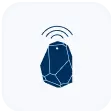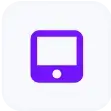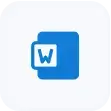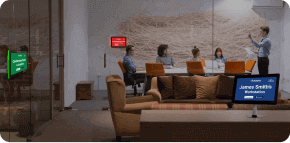Blog

Desk Hoteling-What It Is and Why It’s Key for Modern Workplaces
In previous years, cubicles were efficient for companies as they could reduce their expenses for individual offices. However, over the years, they proved ineffective, as cramped spaces and limited privacy have reduced collaboration and social interaction among employees.
Today, office landscape thrives on flexible workspaces, hybrid work, and more innovative office space management. The rigid approach is a thing of the past. Instead, modern workplaces are defined by flexibility, collaboration and efficiency.
These workspaces are supported by tools like desk hoteling that help with the shift. Using desk hoteling isn’t just the by-product of today’s modern workplaces. It’s not just a trend but a strategy that optimizes office space, empowers employees, and reduces costs.
In this article, we’ll tackle the following questions:
- What exactly is desk hoteling, and how does it work?
- What’s the difference between hoteling and hot desking?
- What benefits does desk hoteling give?
- How do you start office hoteling?
Desk Hoteling: What It Is and How It Works
The idea of “desk hoteling” has become more popular as more offices use hybrid and flexible work models. But what is desk hoteling, and how does it work?
Desk hoteling is a way for employees to reserve a desk for a certain amount of time, just like they would reserve a hotel room. This practice solves the problem of wasted space by making sure that every part of your office is used well.
This is also a flexible option for businesses that need to set up a hybrid system. Using desk hoteling software will let them book workspaces and keep track of reservations in a way that works for both employees and employers.
What’s the Difference Between Hoteling and Hot Desking?
Maintaining physical offices can be challenging, especially for hybrid workplaces. Both desk hoteling and hot-desking are viable options for employees who alternate between on-site and remote shifts.
But what are the differences between desk hoteling and hot-desking? Here are a few to remember:
Hot-Desking
Hot-desking provides seats to in-office employees on a first-come, first-served basis. It’s a type of seating arrangement where employees can come to work on short notice.
That said, here are the downsides to hot-desking:
- Lack of guaranteed availability: The lack of guaranteed availability means that not all employees will have desks on-site.
- Lack of options: Quiet spots may not always be available for those who need to focus. Plenty of distractions may result in a lack of productivity for employees.
- Potential health issues: Multiple workers using the same desk repeatedly can increase health risks.
Hot-desking is great for a flexible and spontaneous environment, but the lack of a reservation system can create problems.
Desk Hoteling
In contrast to hot-desking, desk hoteling gives employees more control and convenience. It is a structured system that offers more support to hybrid and remote workers.
However, some downsides to desk hoteling may make other solutions more viable, such as:
- Demands more work: Desk hoteling is a practice that needs support to set up. Aside from software, you need an effective scheduling system and a virtual floor plan.
- Requires planning: Desks are booked in advance, making it less ideal for emergency meetings or onsite shifts.
- Potential security risks: Desk sharing with hoteling can be risky, especially when employees regularly handle confidential information.
Despite the downsides, desk hoteling is still highly recommended. It’s more structured and can provide both flexibility and the security of a guaranteed desk. You can know about desk hoteling and hot desking in detail.
What Benefits Does Desk Hoteling Give?
With more offices looking for flexibility, desk hoteling solutions have become more popular. Here are some of the benefits that it brings to today’s hybrid and flexible workplaces:
More Efficient Workspace Use
When offices adopt desk hoteling, it promotes efficient usage of workspaces. It also becomes easier to streamline desk and room delegation, minimizing reservation conflicts among employees. Aside from ensuring access to the right desks at the right time, desk hoteling also ensures easier maintenance.
Boosts Collaboration
Desk hoteling is all about pushing flexible workplaces. This method is supported by office layout and reservation software tools. Resulting in remote and hybrid teams to engage in spaces designed for collaboration.
Improves Work-life Balance
Hoteling desks give employees more leeway to plan their schedules compared to traditional work arrangements. They spend much less time commuting and more time being productive.
Enhances Employee Engagement
Remote and hybrid work employees are most productive within flexible work environments. With office hoteling, they can find the workstation they are most comfortable with.
Increased Cost Savings
As a practice, desk hoteling simply offers more savings. It reduces the need for real estate as companies expand. Employees benefit from maximizing office resources to use, such as desks, rooms, and equipment, which are more available instead of being restricted.
Access to Real-Time Workspace Analytics
The desk hoteling system isn’t just a tool but a collection of data. An effective system can provide real-time data analytics. It offers clear insights into how, when, and where your office spaces are being used. These insights should help you make informed decisions that align your work operations.
Gain Deeper Insights with Workforce Analytics
Analyzing data collected from your desk hotel software could help you gain a deeper understanding of the employees’ needs and preferences. The data will help you make evidence-based decisions about everything from cost-cutting to company culture.
Challenges of Desk Hoteling (and How to Overcome Them)
While desk hoteling provides flexibility and efficiency, companies may encounter some hurdles during implementation. Understanding these challenges and preparing solutions ensures a smoother transition.
Common Challenges
Difficulty Adapting
Employees who are accustomed to permanent desks may feel uncomfortable adjusting to a shared workspace system. Losing a personalized workstation can create a sense of instability, especially for employees who value routine.
Double-bookings or System Failures
Without reliable technology, double-bookings or system crashes can quickly disrupt the flow of work. A failed reservation system can leave employees without a desk, causing frustration and wasted time.
Employee Resistance
Change is never easy. Some employees may resist desk hoteling simply because it disrupts the way they’ve always worked. This resistance can lower morale and affect adoption rates if not handled carefully.
Solutions for Desk Hoteling
Training and Onboarding
The key to overcoming resistance is education. Providing training sessions ensures employees understand how to book desks, check in, and troubleshoot common issues. A proper onboarding process reduces confusion and builds confidence.
Transparent Policies
Clear and fair policies make employees feel secure in the new system. Guidelines around desk usage, cancellations, and priority access eliminate uncertainty and promote fairness across the team.
Backup Systems
To avoid workflow disruptions, companies should have contingency plans for technical failures. Whether it’s manual booking procedures or backup software, having alternatives prevents downtime and frustration.
Best Practices for Successful Desk Hoteling
To get the most out of desk hoteling, companies should establish practices that create clarity, consistency, and trust among employees.
Implement a Clear Desk Policy
Since desks are shared, a clean desk policy is essential. Employees should clear personal belongings at the end of their booking to ensure the workspace is ready for the next user. This not only improves hygiene but also fosters respect among colleagues.
Set Communication Guidelines
Employees need to know exactly how the system works. Clear instructions—on booking desks, canceling reservations, or reporting issues—help minimize confusion and keep operations running smoothly.
Collect Employee Feedback
Desk hoteling is most successful when shaped by user experience. Regular feedback sessions or surveys allow companies to identify challenges early and refine the system to better meet employee needs.
Monitor Usage Trends
Data from hoteling software reveals patterns in workspace demand. Monitoring this data helps managers adjust desk layouts, allocate resources more effectively, and even reduce unused space to cut costs.
How Do You Start Office Hoteling?
Desk hoteling is necessary for workplaces that have both in-person and remote work setups. It helps companies give more options to employees and use their office space well. Aside from asking “What is hoteling?”, it’s also good to check if your office is ready for hoteling.
You can start rolling out your new work arrangement by keeping these practices in mind.
Involve Your Employees
Before you make the switch to hybrid work arrangements, be sure to gauge your employees first. It’s important to understand what employees need and how interested they are in their work. Making the workforce ready for new work setups can also help them adapt to the new environment.
Other options might work better, too. For instance, if employees don’t need to be at the workplace most of the time, hot-desking could be a good choice. This means sharing desks, so they use whichever one is available when they come in.
Fit Desks and Meeting Rooms with the Right Technology
Investing in the right hoteling software can make a huge difference. For your employees, it can act as the central platform for securing meeting spaces, office interactions, and so on. That said, office managers should also consider whether employees may be uncomfortable with changes in their existing work arrangement.
Here’s what you should be looking for in a desk scheduling platform:
- Interactive floor plans: Interactive floor plans make reservations easier for employees and wayfinding for visitors
- Third-party integrations: Third-party integrations make more features accessible with as few apps as possible
- User-friendly interface for desktop and mobile: Easier navigation means a lower learning curve, meaning users adjust more easily
- Streamlined visitor management: A visitor management system makes it easier to schedule on-site meetings with clients
Technology Integration with Desk Hoteling
Modern technology enhances the effectiveness of hoteling by making reservations seamless and improving the overall employee experience. Companies should consider integrating:
IoT Sensors
Sensors can detect real-time desk occupancy, ensuring that booked spaces are actually being used. This reduces ghost reservations and provides accurate usage data.
Mobile Apps
Booking and check-in via mobile apps make the process quick and convenient. Employees can reserve desks on the go, saving time and improving adoption.
Calendar Integrations
By connecting with tools like Outlook and Google Workspace, desk hoteling software can sync meetings and desk reservations, ensuring smoother scheduling.
Touchless Check-in
In a post-COVID world, touchless check-ins are becoming standard. They reduce health risks while making the check-in process faster and more efficient.
Offer Different Spaces
Desk hoteling works best when employees have different spaces to choose from. Different teams may have different needs, and different workers have different preferred environments. Having a variety of spaces means employees have options that cater to their work style.
When they are “in their element”, or their preferred work environment, workers can be more productive. That said, what are the different types of workers you may have?
Here are a few types you should remember:
- Independent: Also known as “doers”, they can be determined and hardworking, but need their own space to do their work.
- Flexible: These types of workers are adaptable and value solo work while still being collaborative. However, not all work allows for this kind of balance.
- Cooperative: These types of workers love teamwork and thrive with feedback, but may struggle with working independently.
- Detail-oriented: Detail-oriented workers can be strategic and great at reducing risks. However, they can struggle with working too slowly and being caught up in the details.
Prioritize a Clean and Healthy Workspace
As employees share desks and workstations, it’s best to implement a clear desk policy because it’s important to keep it clean and sanitised. It can be tempting for employees to leave their messy desks for someone else to deal with. This can ultimately lead to a higher health risk, which is a big concern in a post-COVID workforce.
The Bottom Line
Today, physical offices can be challenging to maintain. Aside from commercial real estate costs, new technologies and changing attitudes towards work have reduced their need.
As more offices embrace hybrid and flexible work models, desk hoteling and similar practices have become more popular. It’s seen as a way to make work easier for employees while reducing costs.
With its numerous benefits, hoteling has since become the work arrangement for companies worldwide. There has never been a better time to start office hoteling than now.
Streamline Desk Hoteling with DeskFlex
Enable flexible desk booking, improve collaboration, and maximize workspace efficiency using DeskFlex’s desk hoteling software.
FAQs About Desk Hoteling:
What is desk hoteling?
Desk hoteling lets workers reserve desks or meeting rooms for specific days or times. Like booking a hotel room, it lets them book a space when they need it.
How does desk hoteling work?
Employees use special software to reserve a desk, check in when they get there, and check out when they leave. This system lets employees reserve desks ahead of time, which makes it easier for them to work from home or in a hybrid setting.
What is the difference between desk hoteling and hot-desking?
Employees who hot-desk use desks that are available on a first-come, first-served basis without having to make a reservation. On the other hand, desk hoteling lets employees reserve a specific workspace ahead of time in a structured way.
Why is desk hoteling essential for modern workplaces?
Desk hoteling is important for flexible and hybrid workplaces because it makes better use of office space, lowers real estate costs, and gives employees more freedom when they work from home and from the office.















































 Support
Support  Demo
Demo  Blog
Blog 
